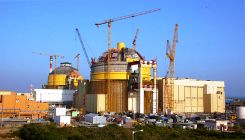By Devinder Kumar | IDN-InDepth NewsReport
NEW DELHI (IDN) – Though the Nuclear Power Corporation of India Ltd. (NPCIL) and Prime Minister Manmohan Singh are at pains to ‘sell’ atomic energy as a “safe, environmental friendly and an economically viable source of electrical energy to meet the increasing need of electricity in the country”, protests continue unabated.
Mass public unease at nuclear power development plans emerged early January at Jaitapur in Maharashtra. Thousands of protestors were held by police on January 3 as they attempted to surround the site of six planned reactors.
Groups representing villagers in the vicinity of the development in western Maharastra state said they were angered by NPCIL’s recent actions to move forward with tenders towards the future power plant’s facilities. They said tenders for a health clinic, fire station and security building showed the national government had not given their concerns sufficient attention and called for the project to be cancelled outright.
The march from surrounding towns to the plant attracted around 2000 people, according to a Business Standard report. Leaders had intended to surround the 1000 hectare site and hand a letter to site managers, but the crowd was stopped and held by police around two kilometres from its destination.
Along with Kudankulam in Tamil Nadu, Jaitapur is slated to host up to six Areva EPR units of a third generation pressurized water reactor (PWR) under a deal struck in December 2010 by India and France. In April 2011 a protest against the plant resulted in the death of one man, 30-year-old fisherman Tavrez Sejkar, during a battle at a police station.
On January 3, protest organisers vowed to prevent contractors from entering the site in future, using a tactic that was successful in delaying the commissioning of the Kudankulam nuclear power plant, which features two Gidropress-designed Water-Water Power Reactor (VVER-1000 units).
In order to allay rising concern and protests near the planned power plants, NPCIL has stepped up its public engagement. In November 2012 it took six local groups on tours of the Kudankulam plant, giving 162 people first-hand experience. Public outreach efforts at events such as cricket matches have also reached hundreds of local people.
Also Prime Minister Manmohan Singh has been trying to convince protestors of the need for atomic power plants. Speaking at the 100th Indian Science Congress in Kolkata early January, he called for “younger generations [to] adopt a science-based value system in order to benefit from what science can offer and to make up for lost time”.
He said: “Complex issues, be they genetically modified food or nuclear energy or exploration of outer space, cannot be settled by faith, emotion and fear, but by structured debate analysis and enlightenment.”
In February 2012, Prime Minister Singh said that groups protesting the start-up of two new reactors at Kudankulam don’t understand the energy situation in India and are based in foreign countries. His remarks came during an interview with Science magazine in which he emphasised the fundamental role that science can play in supporting Indian development.
Singh criticised some sources of opposition to biotechnology: “There are NGO’s, often funded from the United States, and the Scandinavian countries, which are not fully appreciative of the development challenges that our country faces…”
He continued: “You know, for example, what’s happening in Kudankulam. The atomic energy program had got into difficulties because these NGOs, mostly I think based in the United States, don’t appreciate the need for our country to increase the energy supply.”
In line with the scientific management of India’s nuclear program, official messages for the public have emphasised the advantages of nuclear power in terms of economic benefits, carbon dioxide reduction, reliability, statistical safety as well as simply the provision of power on a large scale. But it remains to be seen whether the strategy will be effective in penetrating some of the basic but unfounded fears for rural livelihoods and children’s health that officials accuse anti-nuclear groups of perpetuating.
However, India has assured France of its commitment to the Jaitapur nuclear power project. External affairs minister Salman Khurshid, who held bilateral talks with his French counterpart Laurent Fabius in Paris on January 10, said both sides are committed to ensuring the highest levels of safety in the project.
“Our government remains committed to the Jaitapur nuclear power project. Both sides are committed to ensuring the highest levels of safety in the project,” Khurshid said at a joint press conference.
Nuclear power program
Recent protests notwithstanding, India has an ambitious and largely indigenous nuclear power program and expects to have 14,600 MWe nuclear capacity on line by 2020. It aims to supply 25% of electricity from nuclear power by 2050.
Summing up the program, the World Nuclear Association (WNA) says: India has a vision of becoming a world leader in nuclear technology due to its expertise in fast reactors and thorium fuel cycle.
Because India is outside the Nuclear Non-Proliferation Treaty due to its weapons program, it was for 34 years largely excluded from trade in nuclear plant or materials, which has hampered its development of civil nuclear energy until 2009.
Due to these trade bans and lack of indigenous uranium, India has uniquely been developing a nuclear fuel cycle to exploit its reserves of thorium. Now, foreign technology and fuel are expected to boost India’s nuclear power plans considerably. All plants will have high indigenous engineering content. [IDN-InDepthNews – January 15, 2013]
2013 IDN-InDepthNews | Analysis That Matters
Picture: Kudankulam Nuclear Power Plant | Credit: Wikimedia Commons
Send your comment | Subscribe to IDN newsletter
Follow us on Twitter and Facebook:
http://twitter.com/InDepthNews
http://www.facebook.com/IDN.GoingDeeper

